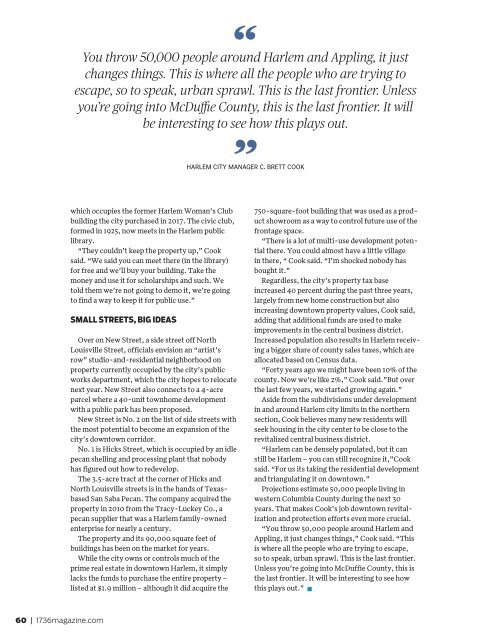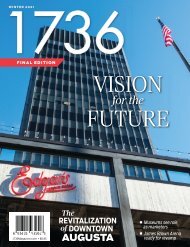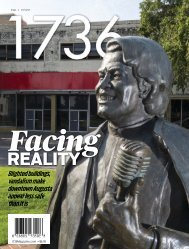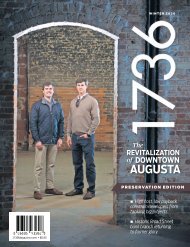Education Edition - 1736 Magazine, Fall 2019
- No tags were found...
Create successful ePaper yourself
Turn your PDF publications into a flip-book with our unique Google optimized e-Paper software.
You throw 50,000 people around Harlem and Appling, it just<br />
changes things. This is where all the people who are trying to<br />
escape, so to speak, urban sprawl. This is the last frontier. Unless<br />
you’re going into McDuffie County, this is the last frontier. It will<br />
be interesting to see how this plays out.<br />
HARLEM CITY MANAGER C. BRETT COOK<br />
which occupies the former Harlem Woman’s Club<br />
building the city purchased in 2017. The civic club,<br />
formed in 1925, now meets in the Harlem public<br />
library.<br />
“They couldn’t keep the property up,” Cook<br />
said. “We said you can meet there (in the library)<br />
for free and we’ll buy your building. Take the<br />
money and use it for scholarships and such. We<br />
told them we’re not going to demo it, we’re going<br />
to find a way to keep it for public use.”<br />
SMALL STREETS, BIG IDEAS<br />
Over on New Street, a side street off North<br />
Louisville Street, officials envision an “artist’s<br />
row” studio-and-residential neighborhood on<br />
property currently occupied by the city’s public<br />
works department, which the city hopes to relocate<br />
next year. New Street also connects to a 4-acre<br />
parcel where a 40-unit townhome development<br />
with a public park has been proposed.<br />
New Street is No. 2 on the list of side streets with<br />
the most potential to become an expansion of the<br />
city’s downtown corridor.<br />
No. 1 is Hicks Street, which is occupied by an idle<br />
pecan shelling and processing plant that nobody<br />
has figured out how to redevelop.<br />
The 3.5-acre tract at the corner of Hicks and<br />
North Louisville streets is in the hands of Texasbased<br />
San Saba Pecan. The company acquired the<br />
property in 2010 from the Tracy-Luckey Co., a<br />
pecan supplier that was a Harlem family-owned<br />
enterprise for nearly a century.<br />
The property and its 90,000 square feet of<br />
buildings has been on the market for years.<br />
While the city owns or controls much of the<br />
prime real estate in downtown Harlem, it simply<br />
lacks the funds to purchase the entire property –<br />
listed at $1.9 million – although it did acquire the<br />
750-square-foot building that was used as a product<br />
showroom as a way to control future use of the<br />
frontage space.<br />
“There is a lot of multi-use development potential<br />
there. You could almost have a little village<br />
in there, “ Cook said. “I’m shocked nobody has<br />
bought it.”<br />
Regardless, the city’s property tax base<br />
increased 40 percent during the past three years,<br />
largely from new home construction but also<br />
increasing downtown property values, Cook said,<br />
adding that additional funds are used to make<br />
improvements in the central business district.<br />
Increased population also results in Harlem receiving<br />
a bigger share of county sales taxes, which are<br />
allocated based on Census data.<br />
“Forty years ago we might have been 10% of the<br />
county. Now we’re like 2%,” Cook said.”But over<br />
the last few years, we started growing again.”<br />
Aside from the subdivisions under development<br />
in and around Harlem city limits in the northern<br />
section, Cook believes many new residents will<br />
seek housing in the city center to be close to the<br />
revitalized central business district.<br />
“Harlem can be densely populated, but it can<br />
still be Harlem – you can still recognize it,”Cook<br />
said. “For us its taking the residential development<br />
and triangulating it on downtown.”<br />
Projections estimate 50,000 people living in<br />
western Columbia County during the next 30<br />
years. That makes Cook’s job downtown revitalization<br />
and protection efforts even more crucial.<br />
“You throw 50,000 people around Harlem and<br />
Appling, it just changes things,” Cook said. “This<br />
is where all the people who are trying to escape,<br />
so to speak, urban sprawl. This is the last frontier.<br />
Unless you’re going into McDuffie County, this is<br />
the last frontier. It will be interesting to see how<br />
this plays out.”<br />
60 | <strong>1736</strong>magazine.com<br />
1117_T_54_AM____.indd 60<br />
10/25/<strong>2019</strong> 12:35:14 PM
















